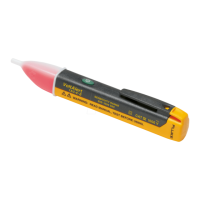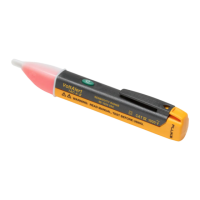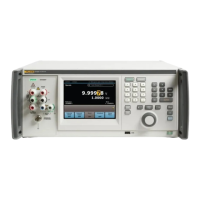5700A/5720A Series II
Operators Manual
6-18
Table 6-2. Annotation for Shift Results Printout (continued)
Q
As with zero shifts, the calibrator calculates how much the full scale point has shifted between the two
calibrations. This is listed in two columns under the “Full Scale Shift” heading. The left column under
this heading indicates how much the output shifted expressed in the units of output for the range. For
example, the +FS point on the 220 mV range shifted from 220.00000 mV to 199.99915 mV between
the previous calibration and the most recent calibration. (220.00000 - 0.00085 = 199.99915)
The right column under the “Full Scale Shift” heading gives the shift expressed in parts per million
(ppm). The formula used is:
shift = 1,000,000 x (full scale shift / full scale range point)
For example, if the full scale shift is -0.00085 mV on the +FS point of the 220 mV range,
shift = 1,000,000 x (-0.00085 mV / +220 mV) = -3.86 ppm.
Note that this is shown as -3.87 ppm in the sample printout. The 0.01 ppm difference is due to
rounding error caused by the limited resolution used in the calculation. The calibrator uses much
greater resolution for internal calculations.
Full scale shift includes all sources of shift at the full scale point that is checked, including both gain
and zero shift components. To determine the gain component of the full scale shift, subtract the
number in the zero shift column from the number in the left Full Scale Shift column.
e.g., for the -FS point on the 220 mV range:
total shift = +0.00047 mV (left column under Full Scale Shift)
zero shift component = -0.00017 mV (Zero Shift column)
gain shift component = +0.00064 mV (subtract zero shift from total shift)
R
This column shows calibrator uncertainty at the full-scale point being checked, using the calibration
interval specified in the setup menu. (e.g., the total specified uncertainty at 2.2V is 6.55 ppm.)
S
The last column expresses full-scale shift as a percentage of specification. The formula is:
shift (% spec) = 100 x (full scale shift / spec (+/-))
Using the 220 mV range example, full-scale shift is -3.87 ppm, and the specification is 10.41 ppm:
shift = 100 x (-3.87 ppm/10.41 ppm) = -37.18% of spec.
T
For ac outputs, the column under the “Point” heading means something slightly different than those
for dc outputs:
FS means the calibrator calculates shift at the full scale point for a low frequency where flatness
correction constants are not applied. This is the shift as a result of changes in range gain constants.
(There is no zero shift component for an ac output.) When calculating uncertainty, the calibrator uses
the full-scale magnitude at a frequency of 1 kHz.
For example, the FS point on the 2.2 mV ac range at low frequencies shifted from 2.200000 mV to
2.199982 mV between the previous calibration and just before the most recent calibration.
(2.200000 - 0.000018 = 2.199982)
When the point describes a frequency, the shift in output is calculated at that frequency. This shift
shows the effect of changes in output due to flatness correction. The instrument calculates the
uncertainty (Spec (+/-) column) using the full scale point and the frequency listed under the Point
column.
For example, the 50.00 kHz point on the 2.2 mV ac range shifted from 2.200000 mV to 2.199983 mV
between the previous and the most recent calibration. (2.200000 - 0.000017 = 2.199983)

